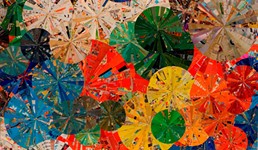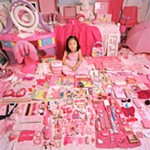Mercedes Wanguemert-Peña's Grand Obsession Stuck Inside Cuba
By Rebecca S. Cohen, Fri., Feb. 16, 1996
Neither does the room-sized, walk-through black-and-white environment describe vignettes from the artist's past. Wanguemert-Peña has developed a well-deserved reputation for making tiny, brightly colored paintings that chronicle her childhood in Cuba: her father fleeing the police, revolutionaries lying dead in the street, the child Mercedes being embraced by her beloved grandfather, riding her tricycle. Such works have been displayed in a "New Works" exhibition at the Austin Museum of Art and a San Antonio gallery. An exhibition at Galeria Sin Fronteras, Recuerdos/Memories, features a large group of these paintings, and another group is displayed at W&TW, too, in the entryway preceding the installation, along with a familiar-looking, battered tricycle the artist found at a local junk shop. Each painting tells a tale, remembered and embellished to the smallest detail. But the installation is something new.
Exilio: Cronica De Una Obsesion (Exile: Chronicle of an Obsession) is just that: the story of one woman's restless need to examine, explain, reinvent, and reveal herself. For Mercedes -- how can we not use her first name after sharing so many stories about her life? -- the relentless focus on Cuba is, in part, her struggle to define the notion of "home" for herself. The artist's childhood home was ripped from her when she was forced to leave Cuba for the United States. Ever since, she has had to carry "home" on her back like a turtle. On the other hand, Mercedes admits, "I am home." Austin is the birthplace of her sons, the city where she raised them, established friendships, where she dreamed of becoming an artist and -- finally -- realized the dream. Making art is Mercedes' obsession every bit as much as keeping the memories of her first home alive.
It is important to note the enormity of the task the artist set for herself and the rapid progression of her art. Mercedes began making her Cuba paintings only some six years ago. She had buried her childhood paintbrushes and colors immediately after her father's death to mourn him. As a young woman, she married an artist; then divorced. But Mercedes always wrapped her Austin world, two sons and a host of needy friends, in hot pink and purple and yellow-gold. She lived in a purple house with red trim and a huge pink shoe on the porch. To make money, she sold painted furniture, then wooden "shoe" boxes that she decorated with glitter, paint, baubles, and outrageous high-heels mounted on top. Finally, the drama of her present -- a mastectomy, a son's ongoing health problems -- and a lingering need to confront the past stirred up stories that needed to be told. Mercedes began making paintings. After about a year, she exhibited some of them at the Texas French Bread bakery on 29th Street. The stories were painted in a naïve style, using hot colors and rhythmic patterns. The work was well received, and suddenly Mercedes was on a fast track. She was invited to exhibit in "real" galleries around the state. The work now at Galeria Sin Fronteras proves her consistent wealth of ideas, imagery, and technique.
Originally, she proposed that same sort of traditional exhibition of her paintings to W&TW. Then, she claims, a mid-life crisis in conjunction with her 45th birthday forced her to expand her reach. No doubt the speedy progress she'd made as a painter also provided courage. Instead of peering into her life through the paintings, viewers would step inside a black and white version of the artist's world, imprinted with "Cuba" and lined with family photographs. They would experience not only her stories but their very origins. In retrospect, Mercedes is amazed at her resolve to tackle so large a project single-handed and is proud of herself for finishing the task. She is also thankful that Chris Cowden, the director of W&TW, was willing to accept her new direction, although she says, "Even if I had nowhere to show [the installation], I still had to do it."
Mercedes worked on the project for about nine months. "It was like a pregnancy, almost," she says. She made the armature for the figures out of wire and learned the art of papier-mâché. "I skipped that class in kindergarten." The artist speaks with a soft Cuban accent that has more to do with cadence than pronunciation. Pausing dramatically, she flashes a smile that slips into a frown, then strains to return to its former position.
It is time to walk through the installation.
A rusty old county jail door serves as the gate. Beyond the open door stands a promenade of stately palm trees with fringed printed-paper fronds and sturdy trunks. The artist has subconsciously, she says, recreated the entry to the cemetery in Havana. First there are the trees, then the marble-like white color of boxy shapes resembling tombstones, cool figures that might be taken for memorial statuary -- if only for a moment -- that had been vandalized.
The figures have no hands. "This is about powerlessness," explains the artist. The absence of hands indicates an absence of power, of control. In this black and white movie-like setting, she says life has lost depth and dimension, along with its color. On the contrary, with an undisturbed view of the installation from the entry, the work appears particularly solid; dramatic and fantastic as Cocteau's Beauty and the Beast, which, Mercedes says, was an early favorite.
There are several groupings of paper-clad luggage and packing boxes on the floor throughout the installation. Cubans of a certain age are transient, according to the artist. They carry a great deal of emotional baggage around, having been pulled abruptly from their homes, often at an early age and with insufficient explanation. Mercedes was 10 years old when she and her three-year-old sister were taken to the airport by their grandparents and sent to Florida to be with their mother and stepfather. She tells how, on the night of the opening, the three-year-old daughter of a friend was playing amidst the boxes just the way her little sister had played with their belongings in the airport. It was life imitating art imitating life, according to the artist.
Black and white photographs from the artist's childhood line the "Cuba" paper-covered walls of the installation. A larger portion of the gallery was available to the artist, but she chose to restrict the space to create a more claustrophobic feeling. It was a wise move. During the opening, crowds of onlookers hugged the walls examining each photo as if they were looking for their own cousins, neighbors, friends. Perhaps it was easier for them to focus on vintage Fifties flashbacks than the naked, albeit newsprint-covered woman in the midst of childbirth or the flabby female who peruses an empty refrigerator. The light from inside the refrigerator sends out an eerie glow.
The gallery's "Exit" sign provides another strange illumination. It glows red -- the only color in the black and white room -- and looks as if it has been intentionally mounted above a small house-shaped structure in the back of the gallery. In fact, when you walk inside the playhouse-size room, there is no exit. Footprints cover the ceiling and walls. There is no way out when you reside deep within an obsession, except perhaps to retrace your steps.
Exilio: Cronica de una Obsesion will travel to San Antonio and to Washington, D.C., and Mercedes is already obsessing about changes she will make in the exhibition -- rearranging the photos on the wall, perhaps adding another figure. She is also thinking about the next medium she will tackle: The artist dreams big dreams for another installation. Still, she actively solicits the audience's response. Having created a mirror that both reflects and distorts experience, she seduces others to stand with her, to enter her world. The installation wraps around uneasily like a too-friendly hug from a stranger. It is impossible to ignore, and finally, so familiar you think you might have visited once before. Perhaps in a dream. n
Exilio: Cronica De Una Obsesion runs through February 24 at the Women & Their Work Gallery.
Recuerdos/Memories runs through March 18 at Galeria Sin Fronteras. Rebecca S. Cohen is an arts writer and recovering art dealer.








